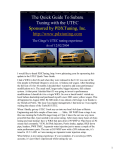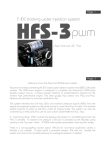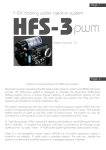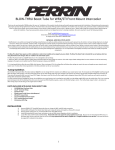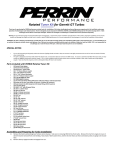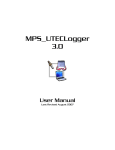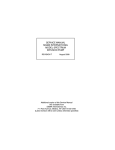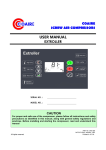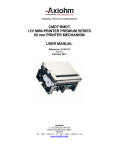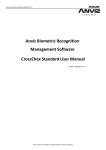Download Here
Transcript
PDXTuning PDXTuning PDXTuning PDXTuning PDXTuning PDXTuning PDXTuning PDXTuning PDXTuning The Quick Guide To Subaru Tuning with the UTEC Part Deux The Ginge’s UTEC tuning experience As of 2007 PDXTuning PDXTuning PDXTuning PDXTuning PDXTuning PDXTuning PDXTuning PDXTuning PDXTuning Picture is from Subiefest 1, where mick_the_ginge placed 2nd in the time attack. Not bad for a wagon. 1 PDXTuning PDXTuning PDXTuning PDXTuning PDXTuning PDXTuning PDXTuning PDXTuning PDXTuning Updates • 09/07/2003 – Initial Version • 02/26/2004 – Added information on 4.1 firmware release • 03/14/2007 – Update based on 5.8 firmware release • General Clean up • Includes tuning with the new Speed Density mode PDXTuning PDXTuning PDXTuning PDXTuning PDXTuning PDXTuning PDXTuning PDXTuning PDXTuning 2 PDXTuning PDXTuning PDXTuning PDXTuning PDXTuning PDXTuning PDXTuning PDXTuning PDXTuning PDXTuning PDXTuning Agenda • UTEC Overview • UTEC and knock • Map Tuning • Fuel – 0% tuning and Open Loop Fueling • Fuel tuning with Speed Density mode • Timing, Boost, Parameters • Logging • Third party UTEC GUI • Spare Solenoid Usage PDXTuning PDXTuning PDXTuning PDXTuning PDXTuning PDXTuning PDXTuning 3 PDXTuning PDXTuning PDXTuning PDXTuning PDXTuning PDXTuning PDXTuning PDXTuning PDXTuning The UTEC User Tunable Engine Computer The UTEC is not a piggyback! Past crossover it has 100% control of fuel, timing and boost Override control of: Fueling Timing Boost PDXTuning PDXTuning PDXTuning PDXTuning PDXTuning PDXTuning PDXTuning PDXTuning PDXTuning 4 PDXTuning PDXTuning PDXTuning PDXTuning PDXTuning PDXTuning PDXTuning PDXTuning PDXTuning Expectations • What you are going to learn The basics required to tune with the UTEC • What you are NOT going to learn • Real WRX/STi tuning! • Caution: This will be enough information to destroy your WRX! • ** READ THE UTEC USER MANUAL ** • This quick guide does not replace it PDXTuning PDXTuning PDXTuning PDXTuning PDXTuning PDXTuning PDXTuning PDXTuning PDXTuning 5 PDXTuning PDXTuning PDXTuning PDXTuning PDXTuning PDXTuning PDXTuning PDXTuning PDXTuning Just in case you did not read the last bullet on the previous page PDXTuning PDXTuning PDXTuning PDXTuning PDXTuning PDXTuning PDXTuning PDXTuning PDXTuning 6 PDXTuning PDXTuning PDXTuning PDXTuning PDXTuning PDXTuning PDXTuning PDXTuning PDXTuning UTEC Overview • How does the UTEC enable more Horse Power? • It doesn’t! BOOST = POWER, TIMING = POWER, FUEL = POWER, the UTEC just enables you to correctly tune for boost and aftermarket parts PDXTuning PDXTuning PDXTuning PDXTuning PDXTuning PDXTuning PDXTuning PDXTuning PDXTuning All EM’s enable you to modify fuel, timing, boost, some do it better than others. High flow exhausts yielding better VE, boost and correct timing enables your EJ block to generate more power. The EM enables you to correctly setup the fueling and timing to match your new parts. 7 PDXTuning PDXTuning PDXTuning PDXTuning PDXTuning PDXTuning PDXTuning PDXTuning PDXTuning UTEC and Knock • UTEC only corrects knock when it is in control of timing: • TPS > Crossover Or when Speed Density Crossover has been met • Timing retarded by default 2 degrees for 100 crank cycles • Continues to retard timing until knock is no longer detected Knock/Detonation is the spontaneous combustion of the end-gas (remaining fuel/air mixture) in the chamber. This occurs after the spark. • Default setting are very sensitive • Which is a good thing unless you have a noisy built block PDXTuning PDXTuning PDXTuning PDXTuning PDXTuning PDXTuning PDXTuning PDXTuning PDXTuning Interestingly the UTEC will still flash the CEL when it’s not in control of timing. It’s just a flashing of the CEL, as the UTEC is not in control of timing no adjustments are made. 8 PDXTuning PDXTuning PDXTuning PDXTuning PDXTuning PDXTuning PDXTuning PDXTuning PDXTuning New Knock Settings • Found Under Parameters -> Knock Constants • Automated knock timing retard is NEW • This is the amount of timing that is automatically taken off the whole timing map after knock is detected. • Automatic retard values are lost once the car is switched off New PDXTuning PDXTuning PDXTuning PDXTuning PDXTuning PDXTuning PDXTuning PDXTuning PDXTuning 9 PDXTuning PDXTuning PDXTuning PDXTuning PDXTuning PDXTuning PDXTuning PDXTuning PDXTuning New Knock Settings Continued • Remember if you are getting knock over and over again, TUNE your map • Max Retard IMO is a little too big (5), if the UTEC has to take out that much timing you’re in big trouble -> Set it at 3 • Raise the window to 10, this is the time between auto corrections 3 PDXTuning PDXTuning PDXTuning PDXTuning PDXTuning PDXTuning PDXTuning 10 PDXTuning PDXTuning 10 PDXTuning PDXTuning PDXTuning PDXTuning PDXTuning PDXTuning PDXTuning PDXTuning PDXTuning PDXTuning PDXTuning PDXTuning Map Tuning Fuel Timing Boost Parameters PDXTuning PDXTuning PDXTuning PDXTuning PDXTuning PDXTuning 11 PDXTuning PDXTuning PDXTuning PDXTuning PDXTuning PDXTuning PDXTuning PDXTuning PDXTuning Choose the fueling mode • The UTEC supports 3 modes of fueling • Classic MAF offset (Don’t use this mode) • Fueling based on MAF offset – Fools ECU to adding/subtracting fuel at give load • Open Loop Fueling (OLF) (Default mode) • UTEC generated MAF based fueling. Past crossover UTEC has 100% control of injector duty cycle based on MAF/MAP/RPM voltage • Speed Density (Way cool) • Fueling based on volumetric efficiency of engine, past crossover UTEC has 100% control of injector duty cycle based on MAP/RPM PDXTuning PDXTuning PDXTuning PDXTuning PDXTuning PDXTuning PDXTuning PDXTuning PDXTuning I would not use Classic fueling mode anymore. Either pick open loop fueling or speed density mode. 12 PDXTuning PDXTuning PDXTuning PDXTuning PDXTuning PDXTuning PDXTuning PDXTuning PDXTuning Fuel Tuning Information applicable to classic MAF modification in 3.1 and 4.1 mode, Open Loop Fueling and Speed Density mode PDXTuning PDXTuning PDXTuning PDXTuning PDXTuning PDXTuning PDXTuning PDXTuning PDXTuning 13 PDXTuning PDXTuning PDXTuning PDXTuning PDXTuning PDXTuning PDXTuning PDXTuning PDXTuning MAP Load Point (MLP) • The UTEC only uses TPS while below the programmed crossover (except for the boost map which is TPS based) • Greater than crossover and the map load is based on boost (MAP) In this example TPS crossover is set to 35% Past crossover the MLP can be viewed in UTEC logger #1 Remember MLP is based on actual boost pressure - MAP PDXTuning PDXTuning PDXTuning PDXTuning PDXTuning PDXTuning PDXTuning PDXTuning PDXTuning 14 PDXTuning PDXTuning PDXTuning PDXTuning PDXTuning PDXTuning PDXTuning PDXTuning PDXTuning Know your MAP based load points • Settings found in SPECIAL CONSTANTS menu • Defined as • Min PSI (0 default) • Max PSI (18 default) Load Column Min PSI Default Max PSI Default 10% 0.0 2.0 20% 2.0 4.0 30% 4.0 6.0 40% 6.0 8.0 50% 8.0 10.0 60% 10.0 12.0 70% 12.0 14.0 80% 14.0 16.0 90% 16.0 18.0 100% 18.0 18+ *Modify Max PSI setting to your desired PSI* PDXTuning PDXTuning PDXTuning PDXTuning PDXTuning PDXTuning PDXTuning PDXTuning PDXTuning Simple, know you load points. When logging you will see loads of data, the most important of these are the rpm and Map Load Point, MLP for short. The MLP is based off the Manifold Absolute Pressure, MAP. The MLP is a range from 0-100%. The above chart shows how the MLP corresponds to MAP if the UTEC defaults are used. For most cars the defaults can be used. The load point or load zone as it is sometimes called is very important data for tuning. When analyzing UTEC log files look at the RPM values and the load point to work out which cell was in use. In the logger files you will sometimes see that the MAP lags behind the MLP. Trust the MLP, it reflects what cell the UTEC is actually using at that time. The logger MAP values are averaged to ease analysis. Tune using the RPM and MLP…. The UTEC always uses absolute pressure even if the logger is set to gauge. 15 PDXTuning PDXTuning PDXTuning PDXTuning PDXTuning PDXTuning PDXTuning PDXTuning PDXTuning Setting the MAX MAP • MAX Mapping must be set BEFORE you continue to tune. • Caution: Stock MAP sensor only reads up to ~23.3 psi • DO NOT SET MAX MAP Higher than this while using the stock MAP sensor Stage Setup Guidelines Stock WRX / Stage 2 Stage 4 WRX Stock STi / Stage 2 Stage 4 STi (Green/Red/GT Turbo) Stage 4 STi with aftermarket MAP PDXTuning PDXTuning PDXTuning PDXTuning PDXTuning PDXTuning MAP MAX PSI 18 20 18 22 30 PDXTuning PDXTuning PDXTuning For information on installing an aftermarket MAP sensor I suggest you search NASIOC as there are a couple of good threads on the subject. I installed the TurboXS MAP sensor in pace of my stock sensor and the recalibrated my ECU to work with the new sensor. Caution: The ECU uses MAP for starting and the first 30 seconds. If you do install an aftermarket MAP sensor in place of the stock one you will need to very carefully calibrate the stock ECU. Get the calibration wrong and your car will not start. The STI is especially sensitive to the MAP settings. 16 PDXTuning PDXTuning PDXTuning PDXTuning PDXTuning PDXTuning PDXTuning PDXTuning PDXTuning Caution When Fuel Tuning • Stock O2 sensor is Narrow-wideband but it’s not recommended to tune against it under WOT • Do not use the WOT AFR reading to tune! • Even when UTEC log reads rich, AFR maybe as high as 12.5:1 (Far too lean without water injection) • Lean AFR’s lead to high If in doubt go RICH (But not too rich as that will cause misfire) PDXTuning PDXTuning PDXTuning PDXTuning EGT’s and possible engine damage • Tune fuel using a real wideband O2 sensor PDXTuning PDXTuning PDXTuning PDXTuning PDXTuning The stock WRX front O2 sensor is wideband but you must not tune against the AFR you read from it. It’s only wideband to enable the ECU is to run in closed loop fuel tuning mode. This is where the ECU monitors the front O2 sensor and try’s to keep the AFR’s at as close to 14.9:1 AFR as possible. The ECU is only in this mode under certain easy driving conditions and the sensor works great within those regions. Outside of these regions the wideband is ignored by the ECU and it runs on open loop mode. Using delta dash I can see that the sensor pegs at about 11.5:1, the UTEC logs read rich under about 12.5:1. I do not trust the stock sensor and highly recommend an aftermarket wideband O2 setup. Loads of good ones around like the TurboXS Tuna and the LM1’s. I have a TurboXS Tuna. I must admit I like the Tuna as the wideband value is displayed right in with the UTEC logs. Anyway, buy or borrow a wideband to enable you to tune your fuel correctly. 17 PDXTuning PDXTuning PDXTuning PDXTuning PDXTuning PDXTuning PDXTuning PDXTuning PDXTuning Tuning the 0% column for NONstock injectors 0% column applies to all RPM’s below TPS crossover • If you have larger than stock injectors you should tune your 0% column using an OBDII Scanner • Effects ECU’s Long Term and Short Term trim values • Typical Stage4 map yields LT values from +20 to –20% • Fine to be within –7% to +7% (I think that -7% to 0 is better) • This is not required if you’re still using the stock injectors • Add/remove a percentage of MAF to get the trims in line. PDXTuning PDXTuning PDXTuning PDXTuning PDXTuning PDXTuning PDXTuning PDXTuning PDXTuning If you are running larger than stock injectors you will have to tune your 0% fuel column. Your goal is to get the ECU’s short and long term fuel trim values as close to 0 as possible. The UTEC cannot read the ECU fuel trims, an ODBII scanner or other logging device such as delta dash can be used to capture the fuel trim values. The ECU can only correct +-25% fueling to compensate for injectors. If you install STi injectors without engine management you will see that the ECU will max out both ST and LT trims at –25. The ECU is trying to remove loads of fuel to compensate for the larger injectors. The UTEC 0% column is used to fool the ECU into thinking that less air is going into the engine thus the injectors do not need to be fired so much. Getting the ST and LT trims under control will lead to a more stable idle and better overall fuel tune. In 3.1 fueling mode getting the ST and LT trims under control is very important. 18 PDXTuning PDXTuning PDXTuning PDXTuning PDXTuning PDXTuning PDXTuning PDXTuning PDXTuning Tuning the 0% column for NONstock injectors – OLF / SD Mode 0% column applies to all RPM’s below TPS crossover • When using open loop fueling or SD • • • • PDXTuning PDXTuning PDXTuning mode the UTEC automatically does 0% fueling compensation. The value used is calculated from the difference between the Stock injector size and the UTEC injector size The larger the difference the more modification is done. Follow the attached notes to work out how to really do it. In SD mode the injector latency also effects the 0% PDXTuning PDXTuning PDXTuning PDXTuning PDXTuning PDXTuning Stock intake or normal sized aftermarket. Say the UTEC stock injector size is set to 400 and the UTEC size is set to 500. This means the UTEC injector size is larger than stock thus the UTEC will remove fuel from the 0%. The larger the difference the more fuel the UTEC will want to remove. It’s actually doing an automatic MAF modification for you. If you have a reflashed ECU for your setup the stock size should match the UTEC size. The UTEC size will be the actual size of your injectors. I think in the future the UTEC will directly calculate the injector duty cycle even in the 0% rather than doing the modification as a MAF offset. BigMAF setups. If you have a BigMAF then it’s a little more complex to work out the values. A bigMAF will flow more air so you cannot use the actual injector size as the UTEC injector size. With a BigMAF it will always be smaller than what you have installed. Remember the UTEC does not know you have a BigMAF and it will fuel based on a stock intake. For example if you have an Sti with Perrin 816 injectors and a BigMaf then I find that setting the UTEC injector size to 650 gets you close. Leave the stock size at 550. If you look at the fuel trims and they are either too positive or too negative change the stock injector size. Have the stock size closer to the UTEC size will mean less fuel is removed. Do this if the trims are positive. More difference will force the UTEC to remove more fuel, do this if the trims are negative. 19 PDXTuning PDXTuning PDXTuning PDXTuning PDXTuning PDXTuning PDXTuning PDXTuning PDXTuning Tuning the 0% column – Simple Tuning Procedure #1 • Warm the car up • Reset the ECU • While in neutral • Rev car from idle to 5000+ RPM while logging LT and ST • Adjust 0% to add/remove fuel where needed – If LT and ST show positive, ADD fuel – If LT and ST show negative, REMOVE fuel • Reset ECU and Repeat • Do this until LT and ST read close to 0 PDXTuning PDXTuning PDXTuning PDXTuning PDXTuning PDXTuning PDXTuning PDXTuning PDXTuning Follow these simple notes to tune your 0% UTEC MLP. 20 PDXTuning PDXTuning PDXTuning PDXTuning PDXTuning PDXTuning PDXTuning PDXTuning PDXTuning Tuning the 0% column – Simple Tuning Procedure #2 • Go drive the car while logging LT and ST • Under load fuel conditions are different • Again adjust 0% column to try and get LT and ST as close to 0 as possible • It’s never going to be perfect, but it should be close TIP: At Idle force ECU to be removing fuel. Idle seems to run smoother PDXTuning PDXTuning PDXTuning PDXTuning PDXTuning PDXTuning PDXTuning PDXTuning PDXTuning Forcing the ECU to take the LT negative at idle does seem to give you a very stable idle but don’t go too far. The transition to your idle 0% setting leads to a rich spot as the ecu transitions into that load zone. Too rich at this point and your car will stall. 21 PDXTuning PDXTuning PDXTuning PDXTuning PDXTuning PDXTuning PDXTuning PDXTuning PDXTuning Delta Dash Log of 0% Tune Very stable idle Nice and stable LT ST not too bad Effect of free air BOV Short Term Long Term PDXTuning PDXTuning PDXTuning PDXTuning PDXTuning PDXTuning PDXTuning PDXTuning PDXTuning This is a Delta Dash log from a quick run. Notice the ST trim jumps around loads. This is normal as the ECU is on closed loop fuel control and uses ST to make quick fuel adjustments. If a ST pattern is spotted by the ECU it uses the more coarse LT trim value to apply a more permanent adjustment. This is called fuel learning and the ECU is very good at it. It’s typical to see steps in the LT trim values. Notice the ST spike, that’s the BOV venting producing a rich condition. The ECU is back in closed loop fuel tuning mode and immediately tries to correct the condition, thus the negative spike on the ST trim. 22 PDXTuning PDXTuning PDXTuning PDXTuning PDXTuning PDXTuning PDXTuning PDXTuning PDXTuning Knock after shift (fuel correction) Add some fuel in these areas to minimize knock after shift • Knock after shift is usually down to two things • #1 Lean conditions just after shift • #2 Large jump in timing just after shift • See knock after shift timing correction • Adding fuel at 5000+ RPM’s in the lower boost range can minimize this effect • Having timing values down in the lower columns also helps PDXTuning PDXTuning PDXTuning PDXTuning PDXTuning PDXTuning PDXTuning PDXTuning PDXTuning While we are on the subject of the 0% column I should also mention something that is being called shift knock. Shift knock is knock that is detected between shifts. This type of knock is down to a couple of conditions. The first is the lean condition that happens as you shift the second is the timing that the ECU runs during the shift. Both the lean condition and the high timing advance lead to knock. These two effects happen when the UTEC gives back control to the ECU. Both knock conditions can be fixed by locking down fueling and timing in the 0% column. To reduce the chance of shift knock add some extra fuel in the 0% column from around 5000 rpm and up. Don’t worry about the fuel trim values, the ECU is in open loop mode at 5000 rpm so the extra fuel will not effect them. This extra fuel reduces the lean condition thus reducing the risk of shift knock. Watch out, if you add too much fuel in this area you could end up with some meaty backfire due to un-burnt fuel in the exhaust. This will damage cats and could also be miss sensed as knock. Also if you happen to do a low load run up to these high rpm’s this extra fuel could cause misfires. 23 PDXTuning PDXTuning PDXTuning PDXTuning PDXTuning PDXTuning PDXTuning PDXTuning PDXTuning PDXTuning PDXTuning Fuel Tuning OPEN LOOP FUELING Mode PDXTuning PDXTuning PDXTuning PDXTuning PDXTuning PDXTuning PDXTuning More on fuel tuning 24 PDXTuning PDXTuning PDXTuning PDXTuning PDXTuning PDXTuning PDXTuning PDXTuning PDXTuning Why Open Loop Fueling • Eliminates the delay in transitioning from closed to open loop fuel control in the stock ECU. • Big issue with the 2004+ WRX ECU. • Enables Programmable Rev limit • Enables injector scaling • Eases fuel tuning when larger than stock injectors are installed • Do not use scaling with a classic style fuel map. PDXTuning PDXTuning PDXTuning PDXTuning PDXTuning PDXTuning PDXTuning PDXTuning PDXTuning The #1 reason the UTEC need to do full fuel control is due to the 2004 WRX closed to open loop transition delay. Basically what was happening was that the ECU was programmed with a delay between closed loop fueling and open loop fueling. In closed loop ECU fueling it tries to target 14.9:1 reading the front O2 sensor. The delay was going into open loop mode where the ECU just has a fuel background map. This delay caused the car to run really lean going onto boost. Knock, knock……. Anyway with the UTEC Open Loop Fueling this issues goes away as the UTEC is creating the background fuel map. This is very cool as it’s MAF based. As soon as you go over the TPS crossover point which the default for OLF is 25% the UTEC is in control. Hence the delay is not an issue as the ECU is now doing nothing. 2 other features are the controllable rev limit and the injector scaling. Injector scaling will help those with larger than stock injectors. If you are using STi injectors don’t use the scaling. Lets face it there are many maps available for these injectors already. Stick with the default scaling and use a standard map. You can still use OLF without injector scaling. Also don’t expect to be able to install 740’s and just set the scaling. It requires more work than that. DO NOT USE INJECTOR SCALING WITH A CLASSIC STYLE MAP>>>>> 25 PDXTuning PDXTuning PDXTuning PDXTuning PDXTuning PDXTuning PDXTuning PDXTuning PDXTuning What is Open Loop Fueling? UTEC MAF BASED FUELING Full fuel control UTEC is 100% in control of fueling past crossover CONSITENT FUELING, no more long term trim offset MAF base fueling UTEC calculates injector duty cycle based on MAF/RPM a UTEC is in full control of fueling PDXTuning PDXTuning PDXTuning PDXTuning PDXTuning PDXTuning PDXTuning PDXTuning PDXTuning Open loop fueling is just a name for the UTEC being in full control of the injectors. Previously the UTEC fueling was an offset of the ECU fueling. The issues with this was if the ECU changed it fueling the UTEC fueling got screwed up. This could happen if the long term trim value changed over time. With OLF the UTEC when in control creates the background map to replace everything that the ECU is doing in respect to fuel. To do this the UTEC reads the MAF signal to calculate the injector duty cycle. Very cool and it takes the UTEC one step closer to being a standalone ECU. 26 PDXTuning PDXTuning PDXTuning PDXTuning PDXTuning PDXTuning PDXTuning PDXTuning PDXTuning Turning on Open Loop Fueling • Requires 4.1 or above firmware • To enable: • Enter the Open Loop Fueling menu option • Turn on Open Loop Fueling. Change to be 1 – On by default in 4.2c and above – New base maps from TurboXS are tuned for OLF Screen parameters may have changed a little since this screen shot was taken PDXTuning PDXTuning PDXTuning PDXTuning PDXTuning PDXTuning PDXTuning PDXTuning PDXTuning Enabling OLF is easy. GO into the OLF menu option of the 4.1 or above firmware and turn OLF to 1. Even if you have STi injectors DO NOT MODIFY THE INJECTOR FLOW. DO NOT MODIFY THE INJECTOR FLOW (scaling) - DO NOT MODIFY THE INJECTOR FLOW - DO NOT MODIFY THE INJECTOR FLOW With OLF enabled I suggest you re-check your AFR’s with a wideband. The OLF background fuel map is close to what the ECU does but not exactly what it does. I noticed that I actually ran leaner at lower load zones and much richer at the top end. But the differences were within acceptable ranges so I stuck with my original map. STI Injectors and larger. The reason that you do not change the Injector flow scaling value is that the map you are running was designed to compensate for stock ECU fueling with larger injectors installed. If you change the flow scale are run a map that has negative values you are going to run super lean.. 27 PDXTuning PDXTuning PDXTuning PDXTuning PDXTuning PDXTuning PDXTuning PDXTuning PDXTuning Changing Injector Flow Scaling • Requires 4.1 or above firmware • To enable: • Enter the OLF menu option • Modify Injector Flow: – Supports 300 to 1000 flow rate UTEC generates AFR curve based on MAF/RPM and scaling factor Actual Size of injectors installed Size the ECU thinks the injectors are PDXTuning PDXTuning PDXTuning PDXTuning PDXTuning PDXTuning PDXTuning PDXTuning PDXTuning If you have a larger than stock intake you will have to be very careful with the value you enter. Too large and your car is going to run lean even with the map zero. Start low and work up. Don’t touch the stock injector size if you have not re-flashed your ECU. 28 PDXTuning PDXTuning PDXTuning PDXTuning PDXTuning PDXTuning PDXTuning PDXTuning PDXTuning Modified Stock Injector Flow Scaling • Start with a low value • The injectors may flow 816cc but do they match your MAF readings • You maybe flowing more air! BigMAF for example • Start with injector flow set at 740 (guess and what I usually use) • Increase this value while monitoring AFR curve with wideband O2 sensor • Fine tune AFR curve using a map overlay PDXTuning PDXTuning PDXTuning PDXTuning PDXTuning PDXTuning PDXTuning PDXTuning PDXTuning Just a reminder that you cannot just enter a flow value and expect everything to work as expected. Modified stock injectors are a great thing for those who need more fuel but even with the UTEC injector scaling you are going to have to fine tune you fuel map. 29 PDXTuning PDXTuning PDXTuning PDXTuning PDXTuning PDXTuning PDXTuning PDXTuning PDXTuning Fuel Map Tuning 0% column applies to all RPM’s below TPS cross over point PDXTuning PDXTuning PDXTuning Past cross over point, Throttle > 25%, load is represented by Mass Absolute Pressure, MAP as defined in the SPECIAL CONSTANTS PDXTuning PDXTuning PDXTuning PDXTuning PDXTuning PDXTuning Just a recap. Under the TPS crossover point the 0% fueling values are used. Over the crossover point the 10-100% load columns are used and the load reference swaps to MAP. 30 PDXTuning PDXTuning PDXTuning PDXTuning PDXTuning PDXTuning PDXTuning PDXTuning PDXTuning Fuel Tuning Table • More positive numbers represent more fuel • A value of 2 is more fuel than an value of 1 • A value of –6 is less fuel than a value of –5 • Get the drift……… You are modifying the Mass Air Flow, MAF, voltage reading by a percentage Applies to both classic and open loop fueling modes PDXTuning PDXTuning PDXTuning PDXTuning PDXTuning PDXTuning PDXTuning PDXTuning PDXTuning The values that you type into the fuel map do NOT represent injector duty cycle they represent a MAF offset percentage. This is the same in both fueling modes whether the ECU is controlling the background fuel map or if the UTEC is running in open loop fueling mode and is controlling the background map. A more positive number represents more fuel, a more negative number represents less fuel. 31 PDXTuning PDXTuning PDXTuning PDXTuning PDXTuning PDXTuning PDXTuning PDXTuning PDXTuning Fuel Tuning >TPS crossover Fueling for Rapid Spool Up Always use a Wideband O2 sensor to tune your fuel values! Over TPS crossover - UTEC load swaps to MAP Keep Low RPM and Low Boost Fuel values on the leaner side This creates HOTTER EGT’s which helps the turbo spool quicker Richen up fuel at mid RPM and mid boost (Safer for your WRX if you don’t have water injection) My AFR target was 12.5:1 up until 2750 RPM PDXTuning PDXTuning PDXTuning PDXTuning PDXTuning PDXTuning PDXTuning PDXTuning PDXTuning Far too often I see threads about slow spool up on the WRX turbo or after market turbo’s with the UTEC. With after market turbo’s some of this is because the things are huge and do have a slow spool up. Some of it is due to the car running really rich in the spool up zones. The UTEC base maps are good but they can be a little rich. This is great and conservative but can lead to slow turbo spool up as the EGT’s don’t get very hot. If you have this issue you should use a wideband O2 sensor and see if you are running rich in the spool up area. 10.5:1 maybe perfect at full boost but 12.5:1 AFR will create hotter EGT’s and aid spool up. Do not lean this area out too much as you will end up losing power. 32 PDXTuning PDXTuning PDXTuning PDXTuning PDXTuning PDXTuning PDXTuning PDXTuning PDXTuning What the MAF offsets actually does Modified Measured RPM MAP MAF TPS Site Count Ign#1 Inj#1 Ign Fuel Boost MAF AFR 5042 +21.9 4.4 100 90 00 +17.0 68.1 +17.2 -4.8 ECU. 4.1 11.76 • In this example the actual measured MAF voltage is 4.4volts • The map applies a -4.8% modification resulting in a modified MAF voltage of 4.1 volts • The Open Loop Fueling uses the modified MAF voltage value as the source of it’s fuel lookup. • The UTEC has a pre-programmed background map that you cannot access. PDXTuning PDXTuning PDXTuning PDXTuning PDXTuning PDXTuning PDXTuning PDXTuning PDXTuning 33 PDXTuning PDXTuning PDXTuning PDXTuning PDXTuning PDXTuning PDXTuning PDXTuning PDXTuning Fueling Part 2 Always use a Wideband O2 sensor to tune your fuel values! AFR data is coming from Wideband Not shown. Much easier with a TXS “Tuna”, AFR data right in the log file Or use UTI – See additional tuning tools at the end Log to correlate AFR/RPM/MAP data back to UTEC load column reference Adjust column to meet target AFR My AFR target was 11.5:1 PDXTuning PDXTuning PDXTuning PDXTuning PDXTuning PDXTuning PDXTuning PDXTuning PDXTuning Funny after all those slides this is the most important. Here you can see a snippet from a UTEC log 1. I was not using the Tuna for this run so you cannot see the AFR data. AFR data was in a separate log from my Tech Edge wideband. To tune you should reference the rpm and the map load points. The MLP’s are highlighted in the above slide. From the RPM and MLP work out which load cell to modify to either add or subtract fuel at that point. I try are target 12:5:1 up to 2750, then come down to 11.5:1 up to 5000 and finally down to 11:1 at redline. Remember to add fuel make the value more positive and to subtract fuel make the value more negative. If you have water injection you should be able to run leaner at the top end. 12:1… sweet. While you are fuel tuning check the injector duty cycle. If it’s already at 100% and you are running too lean then you will have to turn the boost down at that point. Once the injectors hit 100% you cannot add anymore fuel. Notice that you do not enter all of the load zones. You kind of go into ranges of them. This is typical as unless you have access to a load set dyno it’s hard to tune all load zones. For ranges above a zone that are not entered I always go richer and for ranges below a zone that are not entered I always go leaner. Not much either way. Daily driving I enter these other load zones and always check that I’m running more on the rich side than the lean side. 34 PDXTuning PDXTuning PDXTuning PDXTuning PDXTuning PDXTuning PDXTuning PDXTuning PDXTuning Knock correction and Fuel Tuning • Add fuel to correct knock conditions • WRX typical problem areas • Around 4000 RPM (peak boost) • Around 5500-5750 RPM (knock happy area) • Stage4 Map example • Rich around 4000 RPM Caution: Too much fuel will lead to misfire PDXTuning PDXTuning PDXTuning PDXTuning PDXTuning PDXTuning PDXTuning PDXTuning PDXTuning The WRX has a couple of points that seem to be more prone to knock than others, around 4000 and 5500 rpm’s. This I am sure is down to engine design. The knock issues can be reduced by adding a little extra fuel in these areas. You can see these area’s in the timing map as well. Just look at the lower timing values at these points. Do not add too much fuel, just a tad. The hesitation that some people feel with their cars is typically down to running too rich in an area. Just a little extra fuel to help reduce knock conditions. 35 PDXTuning PDXTuning PDXTuning PDXTuning PDXTuning PDXTuning PDXTuning PDXTuning PDXTuning Programmable Rev Limit • Now UTEC controls fueling, it can also control rev limit – Way cool ☺ • Warning: Unless you have strengthened internals changing rev limit could cause serious engine damage STi Default is low IMO. Set if to 72 for a block with stock internals PDXTuning PDXTuning PDXTuning PDXTuning PDXTuning PDXTuning PDXTuning PDXTuning PDXTuning Final note on the programmable rev limit. For those who want to run a little past the ECU set rev limit at 7200 you can with this new feature. Don’t get stupid with this setting. The stock internals were not made to run at 9000 rpm so don’t go their. I like to shift at 7000 rpm and noticed that with the 200 rpm offset of the tachometer I would hit rev limit during a hard shift. My solution was to up the rev limit to 7500. Very sweet shifts now with the launch control set at 6000 perfect for flat foot shifting. 36 PDXTuning PDXTuning PDXTuning PDXTuning PDXTuning PDXTuning PDXTuning PDXTuning PDXTuning PDXTuning PDXTuning Fuel Tuning Speed Density Mode PDXTuning PDXTuning PDXTuning PDXTuning PDXTuning PDXTuning PDXTuning 37 PDXTuning PDXTuning PDXTuning PDXTuning PDXTuning PDXTuning PDXTuning PDXTuning PDXTuning Speed Density Parameter Setup • In Speed Density (SD) mode the MAF sensor is only used BELOW crossover • After crossover fueling is calculated using a based volumetric efficiency table • Load points are RPM/MAP based after crossover • Base table can be offset using values in fuel table • MAF sensor is still required even in SD mode • To Enable SD mode • OLF = 1 (on) • Fuel Mode = (SD mode on (MAF mode off)) • Sorry I did not bother to capture a screen shot of the Fuel Mode on • Don’t forget to set the engine CC, 2L or 2.5L • 2000, 2500 PDXTuning PDXTuning PDXTuning PDXTuning PDXTuning PDXTuning PDXTuning PDXTuning PDXTuning 38 PDXTuning PDXTuning PDXTuning PDXTuning PDXTuning PDXTuning PDXTuning PDXTuning PDXTuning Speed Density Setup Continued • Set UTEC injector size to ACTUAL size of injectors • Examples: • WRX with modified stock “blues” – Set Injector flow to ~800 • STi with modified stock injectors – Set injector flow to ~800 • If stock sized intake then set stock injectors to the size the ECU think are installed Actual injector size PDXTuning PDXTuning PDXTuning PDXTuning PDXTuning PDXTuning PDXTuning PDXTuning PDXTuning 39 PDXTuning PDXTuning PDXTuning PDXTuning PDXTuning PDXTuning PDXTuning PDXTuning PDXTuning SD and the BigMAF • Remember the MAF sensor is still used below UTEC crossover • Still set the Injector size to the ACTUAL size of the injector (SD fueling is calculated from this value) • Monitor the fuel trims as previously discussed and change the stock setting to bring the trims in line • Between 650-700 has worked PDXTuning PDXTuning PDXTuning PDXTuning PDXTuning PDXTuning PDXTuning PDXTuning PDXTuning 40 PDXTuning PDXTuning PDXTuning PDXTuning PDXTuning PDXTuning PDXTuning PDXTuning PDXTuning Injector Latency • The use of the correct injector latency for given injectors in critical in getting the car to idle smoothly and the latency can be used to modify the lower load fueling • Injector latency is the millisecond value added to the injector duty • Added to compensate for the injectors physical mechanical opening delay • Example: • Fuel trims are very minus at idle and light throttle – Increase the injector latency value a little adds fuel which should help with the lean condition • It’s a very small amount so should not offset the higher load fueling that much • If fueling is way off use the standard approach, injector scaling and 0% MAF modification PDXTuning PDXTuning PDXTuning PDXTuning PDXTuning PDXTuning PDXTuning PDXTuning PDXTuning 41 PDXTuning PDXTuning PDXTuning PDXTuning PDXTuning PDXTuning PDXTuning PDXTuning PDXTuning Sample Injector Latency values • Base information from NASIOC thread • Additional “real life” tuning information added A value a little smaller works a little better than the actual latency values specified PDXTuning PDXTuning PDXTuning PDXTuning PDXTuning PDXTuning PDXTuning PDXTuning PDXTuning 42 PDXTuning PDXTuning PDXTuning PDXTuning PDXTuning PDXTuning PDXTuning PDXTuning PDXTuning TPS Crossover • All crossover parameters have to be true for UTEC to go into SD mode • TPS / MAP / RPM settings TPS is fine at 25% unless you really want to tune the 10-20% MLP for a smooth crossover Setting it to 0 means that as soon as the other parameters are met the UTEC enables SD mode fueling Leaving TPS at 25% means cruise AFR is typically under ECU closed loop control, which is good for fuel efficiency PDXTuning PDXTuning PDXTuning PDXTuning PDXTuning PDXTuning If set at 0 tuning of the 1020% MLP is very important. Tune them to 14.7-14.5:1 AFR PDXTuning PDXTuning PDXTuning 43 PDXTuning PDXTuning PDXTuning PDXTuning PDXTuning PDXTuning PDXTuning PDXTuning PDXTuning MAP/RPM Crossover • MAP crossover is split between two values • To calculate the actual MAP crossover point • Take the MAP threshold then add the MAP hysteresis value to it • Example – MAP Threshold = -9 psi – MAP Hysteresis = 2 psi • Crossover happens at -7psi (As long as all other crossover parameters are true) Default settings work pretty well Default RPM setting is fine PDXTuning PDXTuning PDXTuning PDXTuning PDXTuning PDXTuning PDXTuning PDXTuning PDXTuning 44 PDXTuning PDXTuning PDXTuning PDXTuning PDXTuning PDXTuning PDXTuning PDXTuning PDXTuning Speed Density Fuel Tuning • Spend time tuning the low end of the fuel map. This will make for a smooth ECU to UTEC transition Tune lower load points at as many rpm points as possible Volumetric Efficiency (VE). With 0 in the map this would read 100 Lean and mean PDXTuning PDXTuning PDXTuning PDXTuning PDXTuning PDXTuning PDXTuning PDXTuning PDXTuning 45 PDXTuning PDXTuning PDXTuning PDXTuning PDXTuning PDXTuning PDXTuning PDXTuning PDXTuning Example SD Fuel Map With injector size and latency set correctly the fuel map typically has to remove lots of fuel at the lower load points and RPM to achieve 14:1 Higher loads and RPM requires less modification from the UTEC’s base fueling map to achieve 11:1 Tune map in same way as any other fuel mode PDXTuning PDXTuning PDXTuning PDXTuning PDXTuning PDXTuning PDXTuning PDXTuning PDXTuning 46 PDXTuning PDXTuning PDXTuning PDXTuning PDXTuning PDXTuning PDXTuning PDXTuning PDXTuning SD Mode and Temperature • Speed Density is affected by temperature • Typically only intake temp fueling compensation is needed – Coolant correction should be used if you have cold/hot start problems Add fuel when it’s colder than tune temp Remove fuel when it’s hotter than tune temp PDXTuning PDXTuning PDXTuning PDXTuning PDXTuning PDXTuning PDXTuning PDXTuning PDXTuning The thing to remember here is that the reference temperature is the temperature at which you tune the car. Work out what this is by looking at the intake temperature reported in the UTEC dashboard. In SD mode you will have to add more fuel to the tune when the intake charge gets colder, the colder the air the more fuel is needed. As the air gets hotter and lighter then you have to remove fuel to meet your ARF goal. The only time you should have to use the ignition compensation is where the intake charge is very hot. In this case I suggest you remove 2 degrees of timing at the very hot intake temps. Coolant corrections are very handy for cars that seem to have cold or hot start issues. Modded stock injectors are a good example. When the car is very cold the ECU tends to start the car very rich, sometimes overly rich. Coolant compensation can be used to lean out the map just while you are warming up the car. Hey presto, no more black soot on the back of the car. 47 PDXTuning PDXTuning PDXTuning PDXTuning PDXTuning PDXTuning PDXTuning PDXTuning PDXTuning Interesting Log • This is log pretty interesting and shows the power of Speed Density Mode • Can you see why? • Answer: The MAF sensor is pegged! • This is not an issue as it’s only used below crossover. • That’s one smooth fuel curve PDXTuning PDXTuning PDXTuning PDXTuning PDXTuning PDXTuning PDXTuning PDXTuning PDXTuning 48 PDXTuning PDXTuning PDXTuning PDXTuning PDXTuning PDXTuning PDXTuning PDXTuning PDXTuning PDXTuning PDXTuning Timing Tuning Timing ninja fu PDXTuning PDXTuning PDXTuning PDXTuning PDXTuning PDXTuning PDXTuning Time to talk about timing. 49 PDXTuning PDXTuning PDXTuning PDXTuning PDXTuning PDXTuning PDXTuning PDXTuning PDXTuning Timing Map Tuning 0% column applies to all RPM’s below TPS cross over point PDXTuning PDXTuning PDXTuning Past cross over point, Throttle load is represented by Mass Absolute Pressure, MAP as defined in the SPECIAL CONSTANTS PDXTuning PDXTuning PDXTuning PDXTuning PDXTuning PDXTuning Again a reminder. The 0% column is used when you are blow the TPS crossover. Once over this point the 10-100% load columns are used and the reference is swapped to MAP. 50 PDXTuning PDXTuning PDXTuning PDXTuning PDXTuning PDXTuning PDXTuning PDXTuning PDXTuning Timing Advance / Retard Retard Timing – Less degrees before TDC Number of Degrees before top dead center Piston Advance Timing – More degrees before TDC Cylinder Piston Top Dead Center, TDC PDXTuning PDXTuning PDXTuning PDXTuning PDXTuning PDXTuning PDXTuning PDXTuning PDXTuning Some basics. Top Dead Center is the upper most point the piston can ever reach. Timing is measured from this point. Advancing the timing is when you set the spark to happen before TDC as the piston is on it’s way up. This is measured in degrees. Retarding the timing is a phrase used to explain reducing the number of degrees before TDC that the spark happens. 51 PDXTuning PDXTuning PDXTuning PDXTuning PDXTuning PDXTuning PDXTuning PDXTuning PDXTuning Timing Adjustment • Issue: Default maps don’t have timing down in the 10-60% columns – Can cause knock when control passes from ECU to UTEC and back. Needed for cars with BigMAF • Resolution: Move timing values into those area • LEAVE lower RPM 0% under ECU control Smooth transitions in timing minimizes the chance of knock Try to limit steps in timing to less than 3 degrees PDXTuning PDXTuning PDXTuning PDXTuning PDXTuning PDXTuning PDXTuning PDXTuning PDXTuning Some of the issues that are seen with the base maps are that there is no timing values in the lower load zones. What happens is that as control is passed from the ECU to the UTEC the timing values can be vastly different. More than 4 degrees and you can feel it. This jerk sometimes also gets detected as knock. The solution is to put timing values into the lower load zones. Another issue that comes up with timing is what I like to call transitional knock. This is either the above scenario or when the UTEC is in control and timing jumps up or down more that 2 degrees at a time. In the lower load zones having jumps of 4-8 degrees in timing are fine, but under WOT boost conditions you should avoid this. Keep the timing steps to 1-2 degrees at a time. This limits the chances to transitional knock. I have no idea why the car does this, it just does. Smooth transitions up and down are key to a good feeling car. What I like about my car is that the power is always coming on and it feels very smooth. When I go to WOT the boost builds up in a controlled fashion and with smooth transitions in AFR and timing the car feels smooth. I have no hesitations or neck snapping jerks. No one has ever said that my car feels slow either. 52 PDXTuning PDXTuning PDXTuning PDXTuning PDXTuning PDXTuning PDXTuning PDXTuning PDXTuning Knock after shift (timing correction) Use conservative timing values in upper 0% column to minimize the chance of knock after shift ECU runs huge timing advance after high RPM shift. This can cause knock after shift conditions PDXTuning PDXTuning PDXTuning PDXTuning PDXTuning PDXTuning PDXTuning PDXTuning PDXTuning Earlier I mentioned that to cure shift knock you can add fuel in the upper 0% load columns. If you have what you think is shift knock you should also hard code some of the timing values in the upper load zones as well. If you look at what the ECU is doing between shifts you can see that sometimes it wants to run crazy timing values. I have seen up to 41 degrees during a shift. Ripe knock condition. From 5250 on my stage4 I put in a timing value of between 18 and 20 degrees. This seems to reduce the occurrence of shift knock. Again the only draw back of this is if you run into these columns during your daily drive rather than during a shift. If you do you will feel the car hesitate as the timing is locked down. But who redlines their car with less that the crossover TPS. 53 PDXTuning PDXTuning PDXTuning PDXTuning PDXTuning PDXTuning PDXTuning PDXTuning PDXTuning Too much advance! Too much advance leads to KNOCK and engine destruction! At redline, too much advance means very high cylinder pressure BANG – Dead WRX/STi At a point, more advance does not yield more power • At that point more advance just takes you closer to knock • Back timing off 1-2-3 points to create a safe map • Dyno Proven PDXTuning PDXTuning PDXTuning PDXTuning PDXTuning PDXTuning PDXTuning PDXTuning PDXTuning As I have said before too much timing advance can mean death to your engine. I know people who learnt this the hard way! More boost and fuel is going to give you the big jumps in power, keep timing conservative. If you are running pump gas definitely keep timing conservative. One other note to make. If you think your car cannot hold very much timing it maybe due to your spark plugs. Incorrectly gapped plugs will screw your timing up so always make sure you have good plugs and they have been gapped correctly. I use the NGK Iridium plugs: BKR7EIX-11 gapped to 0.028 (good would be between 0.026 and 0.028) I have had no issues with these plugs and this gapping. They don’t come gapped at this value so make sure you gap them. 54 PDXTuning PDXTuning PDXTuning PDXTuning PDXTuning PDXTuning PDXTuning PDXTuning PDXTuning Timing Low Down Retarding ignition would increase EGT’s thus help spool up Negatives: Loss of power because of reduced timing BETTER: Advance timing at the low RPM’s More advance means more power PDXTuning PDXTuning PDXTuning PDXTuning PDXTuning PDXTuning PDXTuning PDXTuning PDXTuning Your car can also hold a stack of timing in the lower load zones. Having timing advance down here produces that low down power that the WRX can sometime lack. This is a hard area to tune as you run through the lower load zones very fast under WOT conditions. I tuned my lower load zones by looking at what the ECU wanted to run in those areas. Remember at the lower load zones the ECU is seeing the same boost levels to could in effect be controlling the timing at this point. It’s not as you have filled in these zones to reduce transitional knock conditions. 55 PDXTuning PDXTuning PDXTuning PDXTuning PDXTuning PDXTuning PDXTuning PDXTuning PDXTuning Timing Values Mid to Top End Watch for knock in the mid rpm range Minimal advance here is good ☺ After 3750 or boost peak RPM’s start ramping timing up 22 – 26 degrees of advance should be safe at redline Smooth Transitions, steps of 1-3 are best Watch for KNOCK ! If you get knock, back off the timing 1-23 degrees at LEAST PDXTuning PDXTuning PDXTuning PDXTuning PDXTuning PDXTuning PDXTuning PDXTuning PDXTuning Here are just some pointers on timing values in your maps. I do not see many differences between timing maps of a stage 1 to a stage 4 car. Yes there are some, just if you are running pump gas the timing seems to be very close match between stages. Minimal timing is used as boost comes on. If you have your boost controller set to have the boost hit hard then you will only be able to run very low timing numbers as it hits. Some of this could be due to over boost. At redline I run 24 degrees, I used to run 26 but I think I was past minimum best timing as I did not gain anymore power. Remember if you get knock and your AFR’s on on target then back off timing 1,2 or 3 degrees. You are no going to lose power. 56 PDXTuning PDXTuning PDXTuning PDXTuning PDXTuning PDXTuning PDXTuning PDXTuning PDXTuning UTEC Boost Controller Setup PDXTuning PDXTuning PDXTuning PDXTuning PDXTuning PDXTuning PDXTuning PDXTuning PDXTuning Moving on, nothing to see here…… 57 PDXTuning PDXTuning PDXTuning PDXTuning PDXTuning PDXTuning PDXTuning PDXTuning PDXTuning PDXTuning PDXTuning Boost Map Tuning Boost Control is TPS/RPM based TPS RPM PDXTuning PDXTuning PDXTuning PDXTuning PDXTuning PDXTuning PDXTuning The UTEC boost controller map is different to the fuel and timing maps as it is 100% RPM/TPS based. At any RPM/TPS point the UTEC can be in control of the boost. As people always ask this, yes you can use an external boost controller with the UTEC. As the fuel and timing maps are MAP based past the crossover the maps will run just fine. I personally use the UTEC boost controller. It’s a little sensitive to external changes and there is a little black magic art in getting to do exactly what you want but when you do it works pretty well. 58 PDXTuning PDXTuning PDXTuning PDXTuning PDXTuning PDXTuning PDXTuning PDXTuning PDXTuning Boost control modes summary • Open Loop Mode • Can’t think of a reason to use this mode • Closed Loop Mode • Advantage: Ramped Boost – Different targets based on TPS/RPM • Disadvantage: Affected by temperature • PID Mode • Advantage: Rock solid boost once tuned • Disadvantage: Boost target is RPM based only PDXTuning PDXTuning PDXTuning PDXTuning PDXTuning PDXTuning PDXTuning PDXTuning PDXTuning 59 PDXTuning PDXTuning PDXTuning PDXTuning PDXTuning PDXTuning PDXTuning PDXTuning PDXTuning Open Loop / Closed Loop Boost Control • Open Loop (Default) • UTEC map sets boost solenoid duty cycle • Closed Loop • UTEC map defines target boost unit, UTEC automatically changes solenoid duty cycle to hit boost target PDXTuning PDXTuning PDXTuning PDXTuning PDXTuning PDXTuning PDXTuning PDXTuning PDXTuning The UTEC boost controller can run in two modes, open loop which is the default and closed loop. Do not get these confused with the fueling options. In open loop boost control mode the values in the map represent a Boost Control Solenoid, BCS, duty cycle. In a nut shell the higher the values the higher the boost. The more BCS duty cycle that is used the more air that is vented out stopping the turbo waste gate from opening. The more vented air the more boost. The less vented air the waste gate gets pushed open and reduces the boost. In closed loop mode the values no longer represent a duty cycle they represent a target boost values. These values are unit less meaning that a value of say 200 does not represent 10 psi while a value of 250 represents 11 psi. They are just units so you will have to figure out what units to use to work on your car. As this is a closed loop system the UTEC will automatically fire the BCS to hit the target boost unit value. 60 PDXTuning PDXTuning PDXTuning PDXTuning PDXTuning PDXTuning PDXTuning PDXTuning PDXTuning Open loop control • I just stuck with the TurboXS map until closed loop was introduced • Used bleed valve to set max boost value PDXTuning PDXTuning PDXTuning PDXTuning PDXTuning PDXTuning PDXTuning PDXTuning PDXTuning Enough said, I never messed with open loop boost control. 61 PDXTuning PDXTuning PDXTuning PDXTuning PDXTuning PDXTuning PDXTuning PDXTuning PDXTuning Closed Loop Control Don’t forget to enable closed loop boost control in special constants • Start with low numbers and work up • Bleed valve effects max boost (set at open 2-3 turns and forget) • Boost Gain value effects max boost • 45-50 seems to work best • Effects boost ramp as well PDXTuning PDXTuning PDXTuning PDXTuning PDXTuning Ramp up the boost, this will make part throttle control feel smooth PDXTuning PDXTuning PDXTuning PDXTuning Don’t forget to turn on closed loop boost control. Caution, don’t forget to turn it on. If you use the closed loop boost values with open loop tuned on you will get 100% BCS all the time. Huge boost…. I did this once by mistake. I had loaded a new version of the UTEC firmware modified all the other parameters but missed boost control for some reason. Crap, my little VF30 hit 25 psi at 3800 rpm…. I did not think a VF30 could do 25 psi… Lucky I was running 103 race gas at the time as if I had got knock I would have definitely blown my engine. Don’t forget to turn closed loop boost control on. The other two black magic variables in the UTEC closed loop boost system are the bleed valve, ABC, and the constant called boost gain. Adjusting both will effect the target values that the unit produce. I use the set and forget method. I have my ABC three turns open and the boost gain set to 48. Then I slowly work out what units produce what boost. If I can’t hit my target I open the ABC a little more and start again. Another thing to do is to ramp up the units in the load zones. Don’t just put you max target in the 50-100% columns unless you like full boost at low TPS values. If you are at 60% TPS you only want 60% of the full boost. If you want full boost you should be at WOT so ramp up the units. Doing this you will also find that you can control you car better in the corners. The last thing you want is to be in a corner, push the throttle down a little at get 19psi of power. Unless of course you are at the track and I have a camera and am standing in a safe place. Then your car sliding off the track backwards always looks good on film. 62 PDXTuning PDXTuning PDXTuning PDXTuning PDXTuning PDXTuning PDXTuning PDXTuning PDXTuning Closed Loop Boost Gain • Lower Boost Gain Values = • Quicker Boost Ramp up • Bigger boost spike Boost Gain related Spike • 45 can yield ~1 psi spike Target Max Boost • Higher Boost Gain Values = • Slower Boost Ramp up • Smaller boost spikes • 50 yields ~0 psi spike • Caution: Boost Gain effects MAX boost value PDXTuning PDXTuning PDXTuning PDXTuning I use 48 ☺ PDXTuning PDXTuning PDXTuning PDXTuning PDXTuning The boost gain controls how fast the boost comes on. Higher numbers represent a slower and more controller gain. Lower values represent faster gain and can aid spool up. The issue with the boost gain constant is that it also generates a boost spike and can also effect you target max boost value. A gain of 45 can yield up to 2 psi of boost spike. You can tune to cope with that. Just reduce the timing around that area. The effect is quite nice, you get that whoosh of extra power as the turbo comes on and that neck snap that lots of drivers like. My wife hates it, but she has neck troubles. Of course in my car her neck is abused as I have race hard Teins, front and rear sway bars and the Perrin PSRS which all leads to a rough road ride. Sweet on the track, just harsh on the road. 48 seems to yield a nice quick boost build up, not neck snapping but you don’t get and over boost spikes. 63 PDXTuning PDXTuning PDXTuning PDXTuning PDXTuning PDXTuning PDXTuning PDXTuning PDXTuning UTEC PID Boost Control • Easy to setup (Enable in Special Constants) • 0% column = Boost Target • 10-100% = Starting duty cycle • Gain setting is used to control ramp • Load is TPS / RPM based TPS Boost Target PDXTuning PDXTuning PDXTuning PDXTuning PDXTuning PDXTuning PDXTuning PDXTuning PDXTuning 64 PDXTuning PDXTuning PDXTuning PDXTuning PDXTuning PDXTuning PDXTuning PDXTuning PDXTuning UTEC Parameters • Split into Five sections • User • Knock • Special • Fueling • Temperature Compensation • It’s best to read the UTEC users manual to understand these. They are fully explained in the manual. PDXTuning PDXTuning PDXTuning PDXTuning PDXTuning PDXTuning PDXTuning PDXTuning PDXTuning Too many parameters to count now, read the manual. 65 PDXTuning PDXTuning PDXTuning PDXTuning PDXTuning PDXTuning PDXTuning PDXTuning PDXTuning Logging • Log 1 seems to be the best for daily logging Boost PSI Actual MAF Volts UTEC Boost modified Open/Closed MAF loop setting Volts UTEC Load Column Look at RPM / Load Column Got any Knock RPM PDXTuning Fuel modify % AFR Ignore PDXTuning PDXTuning PDXTuning ECU Timing Injector UTEC Duty controlled Cycle timing PDXTuning PDXTuning PDXTuning PDXTuning PDXTuning Again the real UTEC manual is the best place for information on the loggers. 66 PDXTuning PDXTuning PDXTuning PDXTuning PDXTuning PDXTuning PDXTuning PDXTuning PDXTuning Log Debugging Always look at the values that lead up to the knock event Boost, Timing, Fuel Too much Boost ? UTEC running too much timing advance? The ECU did not want to run that much timing Too Lean ? Knock PDXTuning PDXTuning PDXTuning PDXTuning PDXTuning PDXTuning PDXTuning PDXTuning PDXTuning When debugging a log file try and look at the events that lead up to the knock event that I am sure you are trying tune out. Things to look for would be the amount of timing you are running and the AFR values. If you don’t have a wideband and in the UTEC logger the AFR reads anything other than “rich” under full boost you are running too lean. Add some fuel and if your injectors are at 100%, lower your boost. 67 PDXTuning PDXTuning PDXTuning PDXTuning PDXTuning PDXTuning PDXTuning PDXTuning PDXTuning PDXTuning PDXTuning UTEC GUI’s Third Party Tuning Tools PDXTuning PDXTuning PDXTuning PDXTuning PDXTuning PDXTuning PDXTuning 68 PDXTuning PDXTuning PDXTuning PDXTuning PDXTuning PDXTuning PDXTuning PDXTuning PDXTuning UTEC Interface – UTI Author - navybluesubaru • UTI is by far the best thirty party UTEC interface on the market • UTI is Free (Donations accepted and recommended) • UTI when used with a wideband O2 will help you fuel tune • Automated logging, alarms and a great dashboard GUI • http://www.dezignduo.com/UTI/phpBB2/ • Read above forum notes to understand usage model PDXTuning PDXTuning PDXTuning PDXTuning PDXTuning PDXTuning PDXTuning PDXTuning PDXTuning 69 PDXTuning PDXTuning PDXTuning PDXTuning PDXTuning PDXTuning PDXTuning PDXTuning PDXTuning UTEC Interface – UTI Author - navybluesubaru UTI Map Editor – Post process table files and automate the fuel map update UTI (Dashboard view) PDXTuning PDXTuning PDXTuning PDXTuning PDXTuning PDXTuning PDXTuning PDXTuning PDXTuning 70 PDXTuning PDXTuning PDXTuning PDXTuning PDXTuning PDXTuning PDXTuning PDXTuning PDXTuning TurboXS UTEC Interface • Rumor mill reports that TurboXS were working on a software GUI that has *realtime* UTEC tuning capabilities • We will just have to wait and see if it ever surfaces PDXTuning PDXTuning PDXTuning PDXTuning PDXTuning PDXTuning PDXTuning PDXTuning PDXTuning 71 PDXTuning PDXTuning PDXTuning PDXTuning PDXTuning PDXTuning PDXTuning PDXTuning PDXTuning Spare Solenoid Usage +12v Red Wire 1N4001 UTEC Plug UTEC auxiliary solenoid supports 2 amps max ! + White / Black Wire Secondary Solenoid Use a secondary solenoid to power higher ampere devices Device/Motor/Other Ex: Water Sprayer Override Switch Diode eliminates EMF switching spike – Optional but recommended PDXTuning PDXTuning PDXTuning PDXTuning PDXTuning PDXTuning GND (Black) PDXTuning PDXTuning PDXTuning I use the spare solenoid to control my TMIC water sprayer. This is how I connected it all up. I have the override switch mounted in the center consol box. Each time I use it I feel like James Bond turning on some gadget.. The solenoid delay off is a nice feature. 72 PDXTuning PDXTuning PDXTuning PDXTuning PDXTuning PDXTuning PDXTuning PDXTuning PDXTuning PDXTuning PDXTuning PDXTuning The End PDXTuning PDXTuning PDXTuning PDXTuning PDXTuning PDXTuning 73 PDXTuning PDXTuning PDXTuning PDXTuning PDXTuning PDXTuning PDXTuning PDXTuning PDXTuning Backup Information – Classic Fuel Tuning Classic Mode Fuel Tuning NOT Applicable to OPEN LOOP FUELING Mode PDXTuning PDXTuning PDXTuning PDXTuning PDXTuning PDXTuning PDXTuning PDXTuning PDXTuning More on fuel tuning 74 PDXTuning PDXTuning PDXTuning PDXTuning PDXTuning PDXTuning PDXTuning PDXTuning PDXTuning Fuel Map Tuning – 3.1 Default 0% column applies to all RPM’s below TPS cross over point (60% by default) PDXTuning PDXTuning PDXTuning Past cross over point, Throttle > 60%, load is represented by Mass Absolute Pressure, MAP as defined in the SPECIAL CONSTANTS PDXTuning PDXTuning PDXTuning PDXTuning PDXTuning PDXTuning Just a recap. Under the TPS crossover point the 0% fueling values are used. Over the crossover point the 10-100% load columns are used and the load reference swaps to MAP. 75 PDXTuning PDXTuning PDXTuning PDXTuning PDXTuning PDXTuning PDXTuning PDXTuning PDXTuning Fuel Tuning • More positive numbers represent more fuel • A value of 2 represents more fuel than an value of 1 • A value of –5 represents more fuel than a value of –6 You are NOT modifying injector duty cycle! X You are modifying the Mass Air Flow, MAF, voltage reading by a percentage PDXTuning PDXTuning PDXTuning PDXTuning PDXTuning PDXTuning PDXTuning PDXTuning PDXTuning The values that you type into the fuel map do NOT represent injector duty cycle they represent a MAF offset percentage. This is the same in both fueling modes whether the ECU is controlling the background fuel map or if the UTEC is running in open loop fueling mode and is controlling the background map. A more positive number represents more fuel, a more negative number represents less fuel. 76 PDXTuning PDXTuning PDXTuning PDXTuning PDXTuning PDXTuning PDXTuning PDXTuning PDXTuning Theory behind MAF based fuel modification • Fools the ECU • A reduction in MAF voltage fools the ECU in thinking that less air is flowing into the engine thus less fuel is required • Injectors duty cycle is reduced • An increase in MAF voltage fools the ECU in thinking that more air is flowing into the engine thus more fuel is required • Injector duty cycle is increased PDXTuning PDXTuning PDXTuning PDXTuning PDXTuning PDXTuning PDXTuning PDXTuning PDXTuning This pretty much explains it all. The value that you type into the fuel map is a percentage offset applied to the MAF signal before either the ECU or UTEC sees it. Lets say that you have stock injectors and you want to add 1% fuel. You would type a 1 in the map load zone. This is saying that you are adding 1% of the MAF signal back on before the ECU or UTEC sees it. Thus the ECU or UTEC increases the injector duty cycle to get them to spray more fuel. It’s not quiet this simple but this is a good enough explanation for us to work with. 77 PDXTuning PDXTuning PDXTuning PDXTuning PDXTuning PDXTuning PDXTuning PDXTuning PDXTuning Why Tune the 0% is using classic fueling mode • Long Term Trim value used in ECU Open Loop (ECU open loop not UTEC) fuel control • Long term value will effect your >63% TPS fuel values • If Long Term is not stable, your >63% TPS AFR will never be stable. • Maybe too rich or maybe too LEAN • Short Term always goes to 0 over 63% TPS PDXTuning PDXTuning PDXTuning PDXTuning PDXTuning PDXTuning PDXTuning PDXTuning PDXTuning Ignore this if you have enabled OPEN LOOP FUELING with the UTEC. With 3.1 UTEC fuel control the fueling is based off the ECU fueling. While ST trim always goes to 0 when the ECU goes into open loop mode the LT trim values is passed across and used as a offset values. If your LT value is not stable and changes from time to time it will effect your overall fuel tune. Solution: Tune the 0% column. Even if you use the UTEC open loop fueling a stable ST and LT leads to a more stable idle and better operation under the UTEC crossover point. 78 PDXTuning PDXTuning PDXTuning PDXTuning PDXTuning PDXTuning PDXTuning PDXTuning PDXTuning PDXTuning PDXTuning PDXTuning The End Thank you PDXTuning PDXTuning PDXTuning PDXTuning PDXTuning PDXTuning 79
















































































